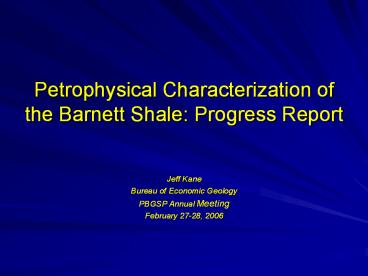Petrophysical Characterization of the Barnett Shale: Progress Report - PowerPoint PPT Presentation
Title:
Petrophysical Characterization of the Barnett Shale: Progress Report
Description:
Petrophysical Characterization of the Barnett Shale: Progress Report Jeff Kane Bureau of Economic Geology PBGSP Annual Meeting February 27-28, 2006 – PowerPoint PPT presentation
Number of Views:477
Avg rating:3.0/5.0
Title: Petrophysical Characterization of the Barnett Shale: Progress Report
1
Petrophysical Characterization of the Barnett
Shale Progress Report
- Jeff Kane
- Bureau of Economic Geology
- PBGSP Annual Meeting
- February 27-28, 2006
2
Overview
- Database construction
- Geophysical log analysis model
- Texas United Blakely 1
- Summary
3
Database construction
- Wireline database
- 7 wells with geochemical data
- 2 with log data
- 1 with mineralogy data
- 1 with limited P P data
- 1 with capillary pressure data
- 2 with core descriptions
4
Database construction
- Many of these core data were recently provided by
Dan Jarvie of Humble Geochemical Services.
5
Geophysical log modeling
- A quick historical perspective
- Mineralogical model
- Kerogen issues
6
Geophysical log modeling some history
- Much of the methodology used today to come from
work performed on the T.P. Sims 2 core (ResTech,
1991) - This methodology derives from work done earlier
on the Devonian Shale (GRI, 1989) - Few data have been published subsequently.
7
Geophysical log modeling - Mineralogy
8
Geophysical log modeling - Kerogen
- Kerogen is a wildcard
- It appears as porosity on logs
- It has a nominal density of about 1.0 to 1.2 g/cc
- (but it is probably more variable)
- It has a hydrogen index of about 0.65 to 0.70
- (water 1.0)
9
Geophysical log modeling - Kerogen
(from Guidry and Olszewski, 1990) where Wk is
the weight of kerogen TOC is the weight fraction
of total organic carbon S1 is the weight
fraction of free oil CS1 is the weight fraction
of carbon in the free oil Ck is the weight
fraction of carbon in the kerogen Guidry and
Olszewski (1990) suggest 0.87 and 0.75 for CS1
and Ck respectively. Jarvie (1999) recommends a
value of 0.83 for CS1.
10
Geophysical log modeling - Kerogen
where Vk is the volume fraction of kerogen Wk
is the weight of kerogen rB is the bulk
density rk is the kerogen density
11
Geophysical log modeling - Kerogen
- The preceding is from derived from core data, not
log data - Initially, correlations have to be developed to
estimate kerogen volume from logs - This work is currently in progress
12
Geophysical log modeling
- We have a mineralogical model of clay, quartz,
calcite, dolomite, pyrite, apatite, kerogen, and
fluids (water and gas) - We have a set of logs that have known or
estimated responses to each of these model points - We can construct a set of equations to describe
these relationships
13
Geophysical log modeling
- This leads to a set of simultaneous equations
that allow us to solve for the volumes of the
geologic constituents present - This is fundamentally the same approach used by
programs such as ELAN and OPTIMA - We use the Geolog package MultiMin
14
Overview of what the logs show
- Texas Blakely 1 wireline log analysis
15
Texas United Blakely 1
16
Texas United Blakely 1
17
Texas United Blakely 1
18
Texas United Blakely 1
19
Texas United Blakely 1
20
Texas United Blakely 1
21
Texas United Blakely 1
22
Texas United Blakely 1
23
Texas United Blakely 1
24
Summary
- We have just begun to build an extensive Barnett
database - We already have a basic model to analyze the
Barnett from wireline logs - Work to date suggest that logs will be of great
value in providing detailed data on Barnett
mineralogy and facies. More core-based work is
necessary to verify this and and refine our
initial model































